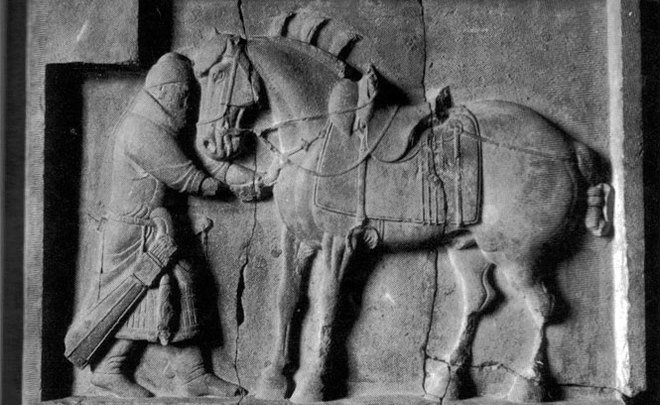
Historically, the Bashkir people numbered more than 40 territorial clan divisions (clan uluses). According to the sherjere legends, members of each clan ascend to a single ancestor. A Russian lexicographer Vladimir Dahl wrote: “From the time immemorial, the people of Bashkurt have been split into tribes or, as we call them, into uluses; each ulus has its own uran, response, tamga, its own tree and bird, as reportedly assigned by Chingiz Khan himself...”. One of such clans was Unlar, it gave the name to the Unlar, Su-Unlar, and Kyr-Unlar uluses, which covered almost the entire territory of the modern Karaidel district, and parts of the Burayev and Askin districts of the Bashkir Republic.
“Heavenly cavaliers”
The outstanding Bashkir ethnographer R.G. Kuzeev wrote: “The Bashkir ethnonym -un-, from our historical and ethnographic data, can ascend to the Hunnic era...” (“An Origin of the Bashkir People”). In his monograph, the scientist did not give sufficient arguments in favor of the hypothesis. Based on current research, it can be argued that the R.G. Kuzeev's opinion was confirmed by the sources. This is a rare and almost unprecedented historical event that an ethnic name was carried through three millennia. The oldest monument of Chinese literature “Shijin” recorded under 827 BC:
In fierce pressure Hun troops rush,
We must hurry toward nomads...
King hurls his army to a far-off march,
To secure peace and order for his kingdom.
By the 3rd century BC the Hun campaigns were so intense that the Chinese generals could no longer to resist. Then the Qin dynasty (aka Chin, hence the China) emperor Shihuan-di decided the question radically: he ordered to build a giant wall along the entire northern border of the country. A wall 4,000 kilometers long was built, at a cost of depleting all the resources of the country, but there was little use of it because Huns still stormed inside China, and as before, border troops straggled fierce battles with the nomads. (The defense wall against the northern nomads was started in the 7th c. BC by various pre-China principalities, and construction continued through the most of the Chinese history.)
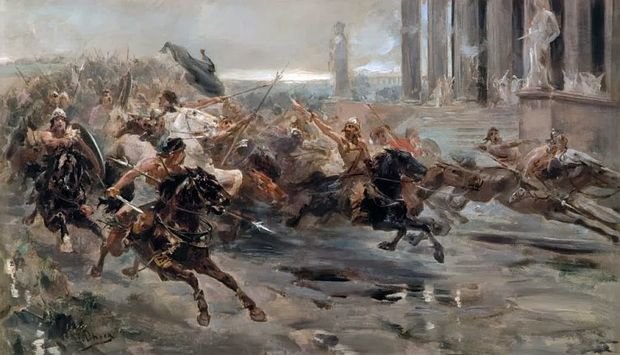
At this time, the Huns gained a talented and decisive leader named Mode, or Maodun, which the American Sinologist F. Hirt considered to be a transcription of the Türkic name Bagatur (mighty hero, Hercules). Mode Bagatur defeated a 320,000-strong Chinese army and forced the Celestial Empire to pay him a tribute. A Chinese poet Li Bo, hailing the valor of the Huns, gave them a vivid epithet “heavenly cavaliers”:
Horses rushing,
Scurrying like wind,
Braves in hundreds
Charging wave.
We depart from home
In the moonlight,
Rising to repulse
“Heavenly Cavaliers”.
“Fall of the Hun Empire”
The Hun state existed for about 200 years, but eventually it fell apart. However, the Huns crumbled not from the weapons, but lured by the glare of the Chinese civilization. As consumers of the Middle Empire goods and luxuries, the case was lost. Once, a Chinese defector Zhongkhang Yue warned Huns about a danger of desire for Chinese goods. Noticing that they liked Chinese silk fabrics, silk cotton wool and produce, he said: “The number of Huns cannot be compared with the population of a single Han province, but they are strong in clothing and food, and do not depend with them on Han [empire]. Now, Shanuy, by changing your customs, and loving Han things, if only 1/10 of Han things would get to the Huns, all Huns would switch to the side of the Han.”
It happened exactly as the wise Chinese said. In the language of science, in the empire of the Huns, as in other nomadic states, there existed a xenocratic (after Scythe Xenocrates, a modern fictitious literary personality), or exopolitic (Extra-Terrestrial), mode of production, when a whole nomadic ethnic group turns into a ruling class that directly or indirectly exploits population of the dependent agricultural civilization (Hunnic Shanyu Maodun concluded a heqin 和親“peace marriage”, aka “peace and kinship” vassalage treaty with China, 198 - 129 BC. China was obligated to provide a royal princess to Shanyu in wives, and agreed upon quantity of tribute “gifts”: malt from glutinous millet, gold, silk fabrics, silk, wool and other things. The exotic terminology and confused elucidation obscures the issue. Zhongkhang Yue's advice was about subjugating to Chinese, not of subjugating the already subjugated Chinese).
Despite political hegemony, any nomadic empire inevitably had to turn into semi-periphery or, as wrote N.N. Kradin, to the militaristic counterpart of the agrarian civilization, since the nomads were completely dependent on the products coming from there (“Empire of the Huns”) (That is Kradin's nonsense intent to whitewash the historical nomadic subjugation of the sedentary states and populations, like the Russians). If the nomads did not want to turn into semi-periphery, they switched from remote exploitation of farmers to the direct conquest of the “center” and founded their dynasties there. So did, for example, the Khitan (Katai), Jurchen and Manchurians, who founded the Liao, Jin and Qing dynasties in China, respectively. True, it was fraught with the loss of originality and complete assimilation among the sea of the conquered population. But there were exceptions to that scheme. For example, the Oguz-Seljuks, who moved to the Asia Minor, not only did not lose their language and traditions, but also laid the foundation of the powerful Ottoman Empire and modern Turkey. As for the Hun Empire, they chose to stick to China’s remote exploitation. However, at the moment when the forces of the Huns weakened, and the Han Empire strengthened, the dominion of the “heavenly cavaliers” came to an end.
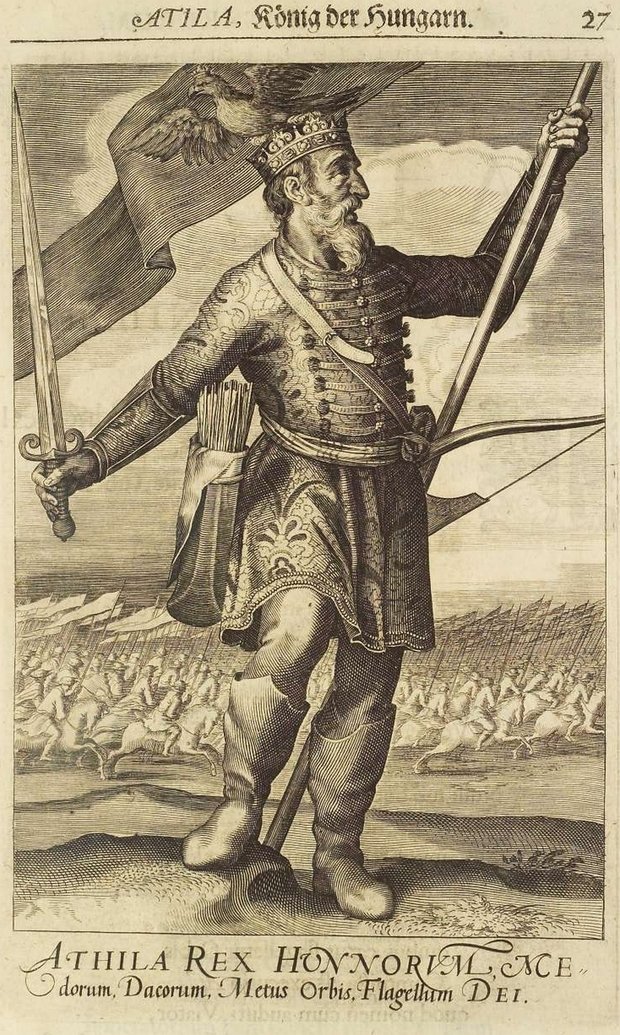
“The Great Migration of Nations”: Balamir and Attila
L.N. Gumilev wrote that at the fall of their empire Huns split into four parts: one submitted to Syanbis (ancient Mongols), the second joined to China, the third, an “indomitable”, with battles retreated to the banks of the Yaik and Volga, and the fourth part, “weak, who could not follow him” (their leader), entrenched in Jeti-su and Dzungaria. The Chinese source called them “weak” because they didn’t have enough horses and therefore combat-ready warriors. “The latter turned out to be the most durable”, concludes L.N. Gumilev (“Huns in Asia and Europe”). They will be discussed below.
As for the “indomitable” Huns, in the 4th century under command of their leader Balamir they crushed Alans (Alan is an allophonic form of Tr. alan, yalan = “steppe”, synonymous with Türkic yaziq “plain, plateau”, Cf. Gu-alan, Türkic quw alan “dry steppe”. The quasi-scientific name Alanya is a retroactive anachronic invention of the 20th c., because the appellation alan is a generic and not an ethnic term, it is applicable for all pastoral steppe populations, synonymous with such generic appellations as Yazygs, Ases, Yases for “steppe”, and Suvar, Tagar/Tokhar for “mountain”) and the Ostrogoth kingdom in the Crimea. In the 5th century, Attila became a successor to the Balamir’s conquest, Europeans nicknamed him “Scourge of god”. In 447, Attila moved his army to Constantinople. In several battles, Roman troops were defeated, and the Eastern Roman emperor Theodosius II capitulated, pledging to pay a huge annual tribute.
In 452, Attila invaded the Western Roman Empire. He destroyed the previously impregnable fortress Aquilea. Then one by one fell Mantua, Verona, Milan, Bergamo. Ahead lay the “Eternal City” of Rome. But then Attila suddenly stopped and voluntarily abandoned the prey at his feet after his meeting with the Rome Pope Leon I “the Saint”. It is not known what discussed the most powerful sovereign of that time and the most powerful man of the West with a rank of “God's vicar on the earth”. Attila only said that it was his great honor to receive “a wisest man in the world”.
Kingdom “Alty Chub”
The “weak” Huns numbering 200 thousand settled in the territory of Jeti-su, in the 5th c. they founded their own state called Yueban by the Chinese records. In the Orkhon monuments of the ancient Türkic inscriptions, it was called “Alty Chub”, that is “six Chubs”. According to L.N. Gumilev, under the “six chubs” should be understood the tribes Chue, Chumi, Chumuhun, Chuban in two sections, and Shato. The Shato group spun off from the Chue: “The Shato is a separate branch of the western Tukue (Türks) of the line Chue... . They lived intermixed with Chue and Chumi.”
The name “Shato” is a Chinese term, meaning the vast sandy steppe between Tien Shan and Altai, where lived this tribe of “Chui”. The Shato themselves did not use it, preferring to be called Unns, as stated below. Due to the endless strife between the tribes of the Türkic Kaganate, in 794 Shato joined Tibetans and helped them to take the Chinese city Beitin. A chronicler says: “When Tibetans raided the borders, Shato always was an avant-garde.”
But in 808 Shato broke up with their allies and set out to their Ordos ancient homeland. L.N. Gumilev wrote: “The Shato Türks were a branch of the “weak” Central Asian Huns whose ancestors did not venture to Europe, but stuck at lake Barkul in Dzungaria. In 808 they rebelled against Tibetans, rejected a patronage of the Uigurs, left their refuge, and 30,000 coaches pulled out toward China. Like an aging salmon in a river or an eel in the ocean, the ethnos went for its birthplace, where Shanyu Mode in 209 BC created a “state on a horseback” and established his “domination over nations” (“The Millennium around the Caspian”).
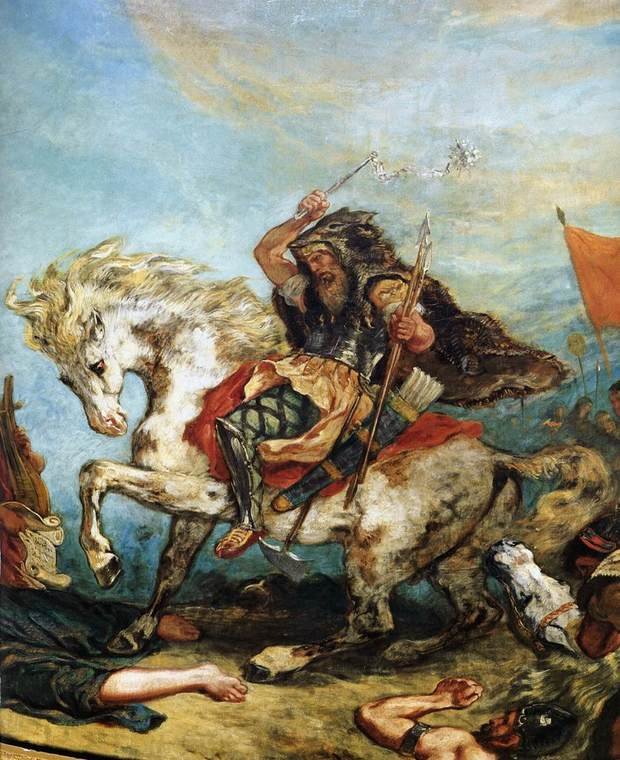
Shato Türks in China
Tibetans bounced in pursuit of Shato. Shato “pursued by the Tibetans,... hoofed and fought.” Of the 30,000 tents, only 2,000 riders reached China. Then the Chinese government scrounged Shato tribesmen from other places and settled them on the northern side of the Yinshan ridge. And since the “Shato were famous for their stamina in battles,” 1,200 “their strong horsemen were organized into a border guard called Shato corps”.
At the end of the 9th century, Lee Khe Yun, a Shato prince, for services rendered to the Middle Empire in the war against the rebels, received a royal title (wang), and his son Lee Tsun-sui in 907 seized northern China and proclaimed himself emperor. His empire Hou-Tang survived till 936. Its territory was then inherited by other Shato states, Hou-Jin (936-946) and Bei-Han (951-979). The last Hun kingdom in China, Bei-Han, capitulated to the newborn Khitan (aka Khidan/Kidan) empire Liao. Summing up the Hunnic epic, L.N. Gumilev wrote: “The last Huns, the Shato Türks, still performed in obscurity their last feats and entered homeostasis (future history) as relic Onguts, or White Tatars. The Greeks and Romans failed in that” (“Old Rus and the Great Steppe”).
The term “White Tatars” attests that Onguts (Türkic “Ten Aliens”) attests that a union of 10 Hunnic tribes in the 10th c. joined a community called Tatars, a motley and uneasy assemblage of coexisting fragments from many languages and origins. The part gut in the name means “tribe”, it is spread across Eurasia from the Atlantic to Pacific, in a variety of articulations around guz and gut, uz and ut, Cf. Goths. The alternation t/z, d/z is still prominent among the Germanic languages. Nominally, the location of the refuge is referred to as Kerulen river. Its advantage was a safety from the Chinese aggression, and the refugees were mostly exiles from the war zones east of the Balkhash lake. Majority, naturally, were the tribes of the Hunnic circle from different time slices, predominantly the Huns, their maternal counterpart Uigurs, the later Uigurs of the Uigur Kaganate, including the Borjigin clan of the Chingiz Khan, and the fragments of the Tele tribes, including Kipchaks and Kimaks. Those were of R1a/R1b Y-DNA male markers. The native areal populace was formed of the Tungus-Manchu stock, with C Y-DNA male markers. The name “30 Tatars” (“Otuz Tatars”) of the Orkhon inscriptions gives a fair idea of the motleyness of the Tatar community. Türkic was a lingua franca of the community, independent of any genetic markers.
Onguts
In order not to become entangled in the mass of ethnonyms, it should be stated that the Huns' autonym was Un (Un in Oguz languages, Hun/Gun in Ogur languages. The initial consonant in Hunnic titles and in the very name Hun attests to the Ogur predominance.). For example, the ancient tradition of Dionysius Periegetes first mentions the Huns around the year 160 under the name of the Unn (ουννοι - unna) (The range of dates for Periegetes is 405 BC to 124 AD). Prisk Pannnonian, who personally visited Attila’s camp, also called them Unns (ουννοι). The form Huns/Guns arose due to the addition of the spirant kh, gh before the initial vowel, which was typical of the Iranian-speaking tribes - Sakas, Sarmatians, Alans (Iranians have nothing to do with the prosthetic consonant, they came to the area too late for that. The classical example of the prosthetic consonant is Ogur gilan/djilan/dilom vs Oguz (Common Türkic) yilan “snake”, Cf. Herodotus' Gelones, Altai Djilan valley. Proto-Indo-Aryans could have picked up that Sarmatian articulation still in the Eastern Europe refuge. Neither Saka, the predecessors of the Türks, nor the Alans have anything to do with Indo-Aryans and Iranians. Manipulating the anachronistic data as an ethnic argument is a preposterous propagandistic disinformation. The tendentious misinformation of a biased interpretation has nothing to do with the history of Onguts). The Chinese term Hunnu also did not reflect the true sound, since it was coined to express derogatory connotations: Hiong-nou (Hun-nu) is “evil slaves.”
The Mongol tribes adjacent to the Shato from the north called them Ongut or Ungut (on/un + plural suffix ut), reflected in the Mongolian annals. This fact eloquently testifies that the so-called “Chui” tribes, or the Yueban “weak Huns” (including Shato), did not forget their ancient ethnonym and were still called Uns.
An Italian traveler Marco Polo, describing Mongolia of the 13th century, also mentioned Onguts: “That place is the the same which we call a country Gog and Magog, and here it is called Un and Mogul; each region has its people, Gog lives in the country of Un, and Tatars live in Mogul”.
That is a wonderful observation in few respects. Marco Polo alludes to a prosthetic consonant and cites both forms, which allows to trace tribes and and attribute them to the modern linguistic classifications of Ogur and Oguz. N.Ya. Bichurin consistently articulated Chinese renditions of the Hunnic terms with anlaut consonants, unwittingly rendering Türkic Hunnic words with prosthetic consonant. That confirms that Huns of the Chinese and European orbits spoke Ogur languages. That also corroborates testimonies of the Huns and Mongols being known to the Mesopotamian compilers of the Hebrew Bible, and of the ethnonym Mongols ascending to the times two millennia older than the appearance of that term in the written monuments.
The Chinese, who called the aggregate of the Mongol-speaking nomads with a collective name “Tatars", to the Shato applied a definition of “White Tatars", which, unlike the “black” and “wild", were “of more subtle appearance, polite and esteemed their parents” (“Men-da Bei-lu”). The Mongols belonged to the “black Tatars”: “The current emperor Chingis, as well as all his generals, ministers and dignitaries are black Tatars”, reports the composition Men-da Bei-lu (“Full Description of the Mongol-Tatars”).
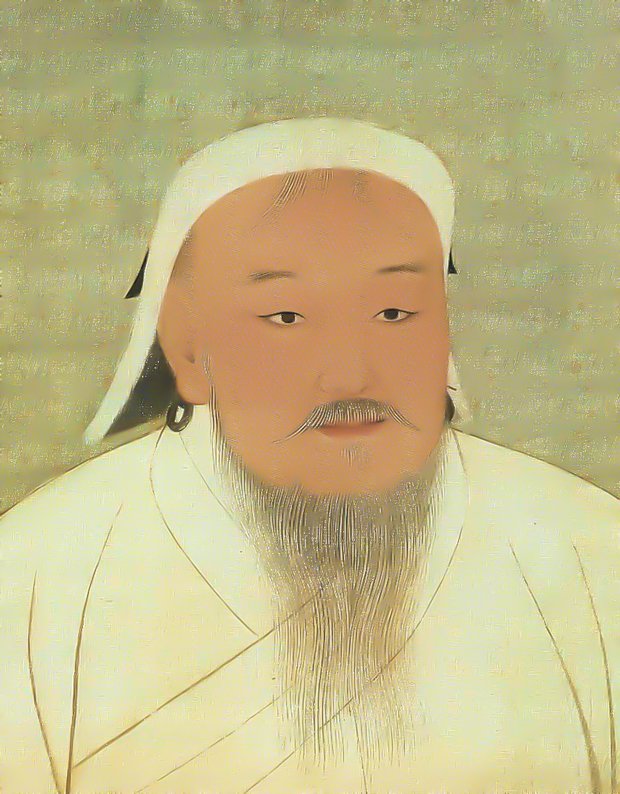
Chingis Khan, interested in a political alliance with Onguts to fight the Jin state, in May 1211 gave his daughter in marriage to the younger son of the Ongut prince Alahus-jigit Khuri.
Chingis Khan and Ongut's Alakush-tegin
Chingis Khan, interested in a political alliance with Onguts to fight the Jin state, in May 1211 gave his daughter in marriage to the youngest son of the Ongut prince Alahus-djigit Khuri, about whom the chronicle Yuan Shi reports: “The younger son Alahus djigit Khuri Boeha married the princess Alakhai-begi.”
The 14th century Persian historian Rashid ad-Din, who called the ruler of the Onghuts Alakush-tegin, describes the events somewhat differently. As a vassal of the Jin Emperor, he guarded passages of the Great Wall of China and was a secret partisan of Chingis Khan. When the latter went on a campaign against the Jin Empire, Alakush-tegin opened to him a guarded passage across the Chinese wall. In gratitude for his service, Chingis Khan ordered to give his daughter Alahai Begi in marriage to the Ongut prince, but that refused this honor in favor of his nephew Shengui. Their son Angudai, in turn, was married to a daughter of Tului-Khan, a younger son of Chingis Khan. And a mother of a fourth Iran's Ilkhan Argun-Khan, Kaimysh-Hatun, was from an Ongut clan. Rashid ad-Din concludes: “That story makes clear that from the Chingis Khan clan they marry their girls to the Ongut tribe, and take girls from them in marriage.” No wonder that Alakush-tegin, like Tamerlane, bore the honorary title Gurgen, that is a “son-in-law” of the Chingis Khan line.
So, the name Ongut clearly shows that the descendants of Shato, a branch of the Central Asian Huns, or the “White Tatars” of the Chinese writings, were called Unns. Subsequently, of these was formed a 5,000-strong corps under a command of five Ongut chiliarchs (commander of a thousand). During Mongol campaigns, part a of Onguts moved far to the west.
Ongut and Ongur are synonyms, gut and gur stand for “tribe” in different articulations, eidetic with the Common Turkic guz. The name Ongur, in turn, is eidetic with the name Onogur, a prominent tribal alliance of the European Late Antique times. The Onogurs, in turn, are associated with the Hungarians, their ethnonym, and their legendary connection with the ethnonym Huns. See Karatay O. White Horvats.
Previously, the clan Ungut was encountered among Kazakhs and Mongols. A19th c. author N.A. Aristov writes: The Onguts, “now completely Mongolized, now make up the aimak Onyut” in Mongolia (“Notes on the ethnic composition of the Türkic tribes and ethnic groups, and information of their numbers”). In the modern PRC (Red China) “autonomous” region Inner Mongolia is a hoshun (qosiɣu, banner/county) Ongniud Banner (Oŋniɣud qosiɣu, Wengniute Qi, 翁牛特旗), which means “Banner of Oŋnyds", that is, Onguts.
Bashkirs of the Ungut/Unlar clan
Among Ba shkirs also survived a splinter of the ancient Huns, a clan Ungut or Unlar (-gut “tribe”, -lar pl. suffix). At first they used the ethnonym as brought from Mongolia, and in the 17th c. they changed it to the Türkic calque, replacing the Mongolian formant plural -ut to the Türkic -lar.
The fact that the name of the Bashkir clan Unlar corresponds to the ethnonym Ungut is beyond doubt. The following document on the events of the Bashkir uprising of 1662-1664 proves their identity. It lists the Bashkir uluses in the vicinity of the Siberian Road supporting Kuchum dynasts in their claims to the Khan power in Bashkortostan: “Tsarevich Bugay Sultan stands in the steppe beyond Iset near lake Iretash, and with him are Bashkir traitors: Syngrans, Bushkurts, Songuts, Tersyaks, Ayls” (Additions to historical acts, collected and published by the archeographic commission. SPb., 1851. Vol. 4, p. 290). The Songuts mentioned in the source (Su-Unguts, or “River Unguts”) correspond to the Su-Unlars, the Bashkirs of the so-called Su-Unlar ulus located along the river Kara-Idel.
Bashkirs of the ancient clan Unlar now live in villages Yakup, Halil, Yanseit, Akbulak, Yuldash, Tuyush, Tegermen Abdullah, Malikovo, Shamratovo, Mata, Kara Yar, Burungut, Dürtüli, Kadysi, Canton in the Karaidelsky District, in the aul (village) Upkankul in the Askin District, and in the villages Kashkalevo, Old Kizgan, Old and New Kkaragush, Dautlar and Bakaly of the Buraev district of the Bashkir Republic.
Salavat Hamidullin, photos provided by the author